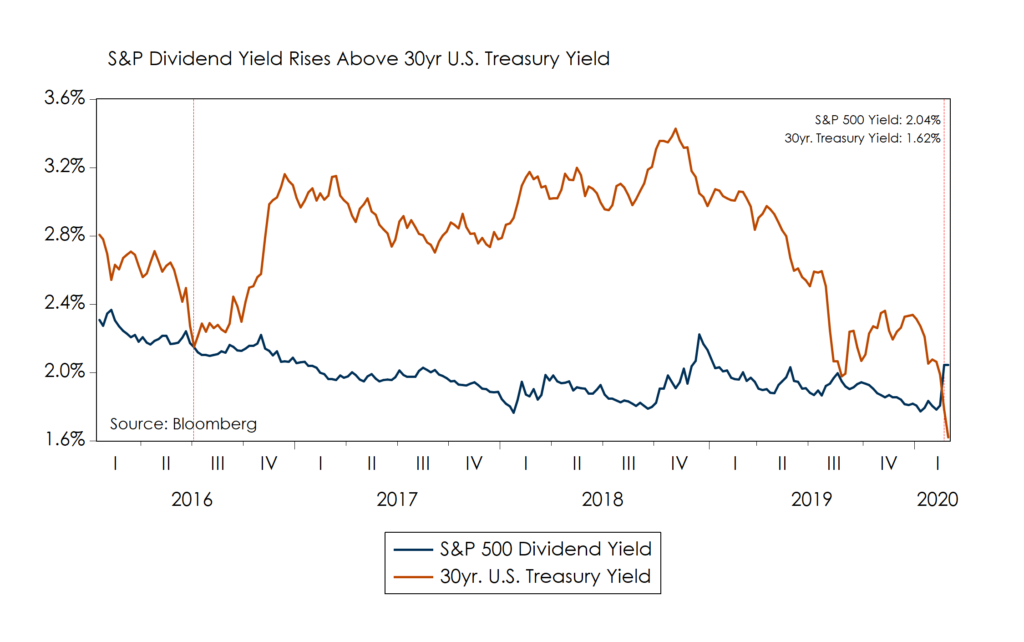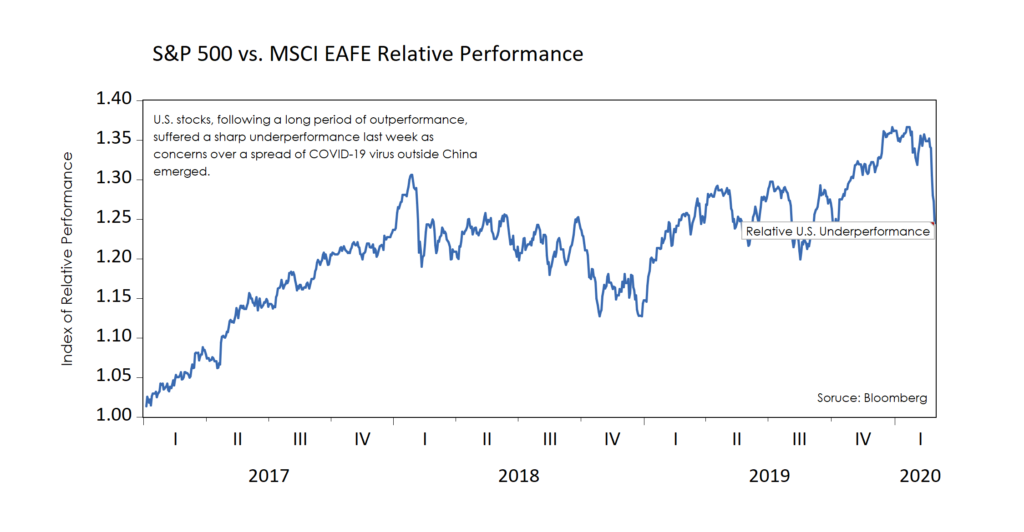Markets React to Coronavirus Spread
The spread of coronavirus outside China hit markets hard last week. Stocks fell on reports of new infections and deaths in Italy and elsewhere. The sharp drop in stock prices, coupled with a plunge in Treasury bond yields, leaves the S&P 500 dividend yield now higher than the 30 year U.S. Treasury yield (first chart, below). Domestic stocks suffered more significant declines than foreign due to concern the virus could spread in the United States (second chart, below). The chart shows pronounced weakness in the S&P 500 (a measure of domestic stock performance) versus the MSCI EAFE index (a measure of non-U.S. stock performance). This weakness highlights how concerns are shifting from China to the rest of the world as signs emerge that the coronavirus may spread to the rest of the world.


Evidence of Slowing Mounts
According to a recent analysis by FactSet, most companies are saying it is too early to quantify the financial impact of the virus. However, it is becoming clear that the coronavirus will have a sizeable impact on global growth in the first quarter, especially in China. According to weekend reports, surveys of China’s purchasing managers (PMI) point to record declines in China’s output and activity in February. China’s February manufacturing PMI fell to a record-low 35.7 (45 expected and 50 last month). Not only did we see China’s purchasing managers indices plunge, but U.S. companies doing business in China are reporting significant disruptions as China implements measures designed to contain the spread of coronavirus. Under these conditions, it is hard to imagine China’s economy finding its way to growth this quarter.
In recent comments, companies report:
1. China supply chain bottlenecks;
2. Higher costs of Chinese operations;
3. Slower Chinese sales;
4. Store closings;
5. Reduced Chinese financial transactions;
6. Severe disruptions in Chinese movement and travel;
7. Shortages for some goods inside China; and
8. A more delayed return to normal than expected.
On the plus side for China, it appears that the number of confirmed new cases there is going down dramatically. Over the past few days, new Chinese cases of the virus are down to roughly 200-500 cases daily, versus 2,000-4,000 cases a few weeks ago.
Spread Sparks Concern
Last week, markets learned that the coronavirus had spread outside China. Financial conditions worsened throughout the week as markets assessed the potential impact. The world’s equity markets lost roughly $5 trillion, or 6%, in value last week. The last time markets fell by this much in a week was in early 2016. Back then, plunging oil prices and faltering global growth were investor’s chief concerns.
Beyond declining stock values and the sharp underperformance of U.S. stocks in recent days, we saw other signs of weakness emerge last week. These new signals include:
1. Tightening European financial conditions;
2. A jump in U.S. credit spreads;
3. A further lowering of long-term bond yields;
4. Sliding long-run inflation expectations; and
5. Renewed weakness in commodity prices.
Some Good News
Against this backdrop, we saw a few positive developments, too. For example, few signs of stress within the U.S. banking system are evident and expectations of further central bank accommodation are rising. Moreover, credit spreads are relatively well behaved and are currently near average levels, despite last week’s 40 basis point (0.4%) widening. The Moody’s Baa-10-year Treasury spread remains near the 10-year average of 260 basis points, or 2.6% above, the yield on U.S. Treasuries, for example.
Last week we saw signs of improved European business confidence through mid-February. The German Ifo and French business confidence surveys, for example, both made progress and beat expectations. In the United States, we continue to see strength in employment and the profit outlook.
Portfolio Considerations
The coronavirus appears to be having three simultaneous effects relevant to portfolios. First, the virus’ spread threatens temporary disruptions in demand for goods and services. Second, companies will experience supply disruptions, higher costs of procuring some inputs, and many will struggle to manage inventory. As a result of these effects, forecasts for Q1 S&P 500 earnings, which have only been cut 3.3% thus far according to FactSet, likely will need to come down along global growth expectations.
We
continue to believe it is essential to limit exposure to companies with high
debt, uncertain cash flows, or weak profitability measures. We are further
sharpening our focus on high-quality companies, rather than pursuing cheap
stocks, fast-growth stocks, or high yield stocks. We expect to deploy cash and
make substitutions by following our long-established discipline of investing in
quality at the right price.
During market crises, it is important not to lose perspective or abandon an
investment discipline.
Kevin Caron, CFA, Senior Portfolio Manager
Chad Morganlander, Senior Portfolio Manager
Matthew Battipaglia, Portfolio Manager
Steve Lerit, CFA, Client Portfolio Manager
Suzanne Ashley, Analyst
(973)
549-4168
www.washingtoncrossingadvisors.com
www.stifel.com
Index descriptions
The Standard & Poor’s 500 Index is a capitalization-weighted index that is generally considered representative of the U.S. large capitalization market.
The MSCI EAFE Index (Europe, Australasia, and the Far East) is a free float-adjusted, market capitalization index that is designed to measure the equity market performance of developed markets, excluding the U.S. and Canada.
Disclosures
WCA Fundamental Conditions Barometer Description: We regularly assess changes in fundamental conditions to help guide near-term asset allocation decisions. The analysis incorporates approximately 30 forward-looking indicators in categories ranging from Credit and Capital Markets to U.S. Economic Conditions and Foreign Conditions. From each category of data, we create three diffusion-style sub-indices that measure the trends in the underlying data. Sustained improvement that is spread across a wide variety of observations will produce index readings above 50 (potentially favoring stocks), while readings below 50 would indicate potential deterioration (potentially favoring bonds). The WCA Fundamental Conditions Index combines the three underlying categories into a single summary measure. This measure can be thought of as a “barometer” for changes in fundamental conditions.
The information contained herein has been prepared from sources believed to be reliable but is not guaranteed by us and is not a complete summary or statement of all available data, nor is it considered an offer to buy or sell any securities referred to herein. Opinions expressed are subject to change without notice and do not take into account the particular investment objectives, financial situation, or needs of individual investors. There is no guarantee that the figures or opinions forecasted in this report will be realized or achieved. Employees of Stifel, Nicolaus & Company, Incorporated or its affiliates may, at times, release written or oral commentary, technical analysis, or trading strategies that differ from the opinions expressed within. Past performance is no guarantee of future results. Indices are unmanaged, and you cannot invest directly in an index.
Asset allocation and diversification do not ensure a profit and may not protect against loss. There are special considerations associated with international investing, including the risk of currency fluctuations and political and economic events. Investing in emerging markets may involve greater risk and volatility than investing in more developed countries. Due to their narrow focus, sector-based investments typically exhibit greater volatility. Small company stocks are typically more volatile and carry additional risks, since smaller companies generally are not as well established as larger companies. Property values can fall due to environmental, economic, or other reasons, and changes in interest rates can negatively impact the performance of real estate companies. When investing in bonds, it is important to note that as interest rates rise, bond prices will fall. High-yield bonds have greater credit risk than higher-quality bonds. The risk of loss in trading commodities and futures can be substantial. You should therefore carefully consider whether such trading is suitable for you in light of your financial condition. The high degree of leverage that is often obtainable in commodity trading can work against you as well as for you. The use of leverage can lead to large losses as well as gains.
All investments involve risk, including loss of principal, and there is no guarantee that investment objectives will be met. It is important to review your investment objectives, risk tolerance and liquidity needs before choosing an investment style or manager. Equity investments are subject generally to market, market sector, market liquidity, issuer, and investment style risks, among other factors to varying degrees. Fixed Income investments are subject to market, market liquidity, issuer, investment style, interest rate, credit quality, and call risks, among other factors to varying degrees.
This commentary often expresses opinions about the direction of market, investment sector and other trends. The opinions should not be considered predictions of future results. The information contained in this report is based on sources believed to be reliable, but is not guaranteed and not necessarily complete.
The securities discussed in this material were selected due to recent changes in the strategies. This selection criteria is not based on any measurement of performance of the underlying security.
Washington Crossing Advisors LLC is a wholly owned subsidiary and affiliated SEC Registered Investment Adviser of Stifel Financial Corp (NYSE: SF).



